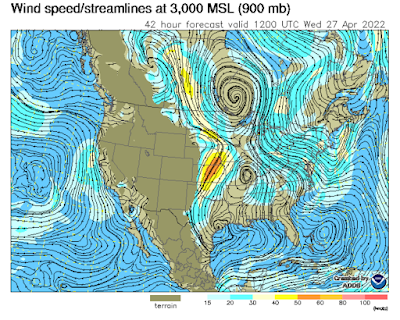Andy Kozak (2R) writes:
May 31, 2024 - My most spectacular flight!
The Skysight forecast was for strong NNW winds with high cloud bases. I had left my glider in the trailer overnight at Post Mills Airfield and was once again going to fly with Tim Chow (BU) and Greg Hanlon (JR). The morning sky showed lenticular clouds, indicating the presence of wave, although Skysight had not predicted wave. We prepared our oxygen systems. My pulse oximeter system can be preset to automatically provide oxygen once I am over 10,000 feet. All I then have to do is put on a nasal cannula.
The goal for the day was Sugarloaf mountain. in Maine, 250 miles round trip.
Here are Tim and Greg over Lake Fairlee. Post Mills is just to the left of the lake.
I topped off first and set off hoping to spend at least some of the day leading. This would not last long. After a climb over Piermont Mountain, I was a bit higher so I probed the leading edge of the cloud, hoping to connect to wave. Tim and Greg continued on course and I was suddenly off course and behind.
For any sustained longer term flight, being able to thermal in consistent, steeply banked (45+ deg.) circles is critical. The NESA 1-34 is great for this with relatively good performance and a good trim control to reduce your workload. It helps to have a relaxed, light touch on the controls.
Finding myself behind I was anything but relaxed and my thermaling showed. Greg reported good lift over Mount Lafayette but by the time I got there it may have been too late, or I was just not flying well.
The thermal seemed broken up; there was noticeable strong drift over the 5,000 foot peaks, and I did not have a lot of room to work with. I was forced to penetrate out toward the northern entrance to Franconia notch. I flew through what seemed the worst extended sink and strongest turbulence I have experienced.
Then, as if by magic it all changed. I turned the corner past Mount Lafayette and flew over of the north facing Lafayette ridge. A two place ship from the Franconia club was thermaling further to the east along the ridge. It was bright and sunny, with smooth air. After gaining some altitude on the ridge I headed for the clouds in the valley. I was somewhat low but within an easy glide of either Franconia, Mount Washington or Twin Mountain airfields.
After gaining altitude over Cherry Mountain, the clouds provided mostly straight line flight with minimal circling toward Mount Washington. At 9,000 feet. I put on the nasal cannula. I passed just to the south of the summit. To my surprise there was no sink. Lift seemed to come in surges that threatened to pull me up into the clouds. I blundered about over the Carter range until Tim suggested I fly back toward Mount Washington and over the “Horn”. This is the sharp, uphill, left turn under my wingtip:
It used to be customary that drivers on the Mount Washington auto road sounded their horn at this turn. The road was narrower at that time. It is a well known location for wave lift.
I found smooth, steady 2-3 knot lift. Not very strong for wave. Greg and Tim had topped out at 13,000 feet and headed NE toward Old Speck Mountain, but I was too low to follow and very content to continue climbing.
In this photo you can see Huntington Ravine as the prominent rock bowl in the lower left third of the frame and at the bottom you can see snow in Tuckerman ravine, a mecca for extreme skiing.
And here I am at 16,500 feet next to a lenticular cloud:
At that point I noticed a much higher lenticular cloud had formed just to my south. I lost some altitude getting to it but there was good lift along its leading edge:
At 17,800 feet I headed away from the lift so as not to violate Class A airspace. It looked like the cloud and likely the lift, extended another 10,000 feet higher.
The flight back was smooth and fast. Once at cumulus cloud level, turbulence restarted and continued down to the ground.
We never reached our goal but found something special. The White Mountains are beautiful viewed from the air as well as from the ground. Add cumulus and lenticular clouds and their associated shadows and the views on this flight were spectacular. The OLC link is here.














